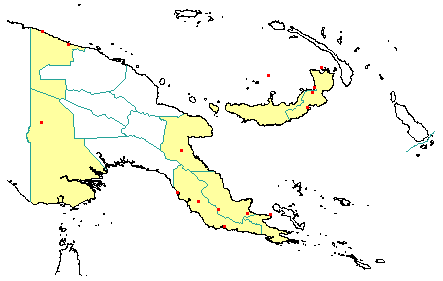
in PNGplants database
PNGTreesKey – Pouteria myrsinodendron (F.Muell.) Jessup |
Barry Conn (NSW) & Kipiro Damas (LAE).
Guide to trees of Papua New Guinea
Copyright held by the authors, National Herbarium of New South Wales, and Papua New Guinea National Herbarium
Austrobaileya Vol. 6: 163 (2001)
Family: Sapotaceae
Dicotyledon
Timber Group: Major exportable hardwood
Field Characters: Large canopy tree (up to 30 m high); Bole cylindrical (c. 30 cm diam.); straight; buttresses buttresses present (usually not very well developed, often trunk shallowly fluted); spines spines absent; aerial roots aerial roots absent; stilt roots stilt roots absent; Bark grey or brown, slightly rough or smooth, fissured or slightly pustular, lenticels elongated vertically; Subrhytidome (under-bark) green; less than 25 mm thick; bark blaze consisting of one layer; faintly to non-aromatic; outer blaze reddish white, pale pink, or pale brown, with stripes, granular with splinters; inner blaze reddish white, pale pink, or pale brown, with stripes, granular with splinters; bark exudate (sap) present, white/milky, not readily flowing (spotty), colour not changing on exposure to air, sticky; terminal buds not enclosed by leaves.
Indumentum: Complex hairs absent; stinging hairs absent; mature twig indumentum (hairs) absent.
Leaves: Leaves spaced along branches, spiral (leaves occurring singly at a node and arranged spirally up the branchlet), simple (a leaf composed of a single blade); petiole present, not winged, attached to base of leaf blade, not swollen; leaves broadest above middle or broadest at or near middle, 12.0-25.0 cm, 4.5-10.0 cm; symmetric, entire, not dissected or lobed, rounded, venation pinnate, secondary veins open, prominent or not prominent, but visible, intramarginal veins absent; leaves lower surface pale green, upper surface green, indumentum (hairs) absent; absent; domatia absent; stipules absent.
Flowers: Inflorescence axillary (pleasantly aromatic), flowers single, cones absent; flowers bisexual, stalked, flowers with many planes of symmetry, 2.5-3.0 mm long, diameter small (up to10 mm diam.) (c. 3 mm diam.); perianth present, with distinct sepals and petals whorls, inner perianth pale green; 5, some or partly joined; stamens 5, present (short, with anthers included within corolla), free of each other, joined to the perianth; ovary superior, carpels joined (when more than one), locules 1-5; styles solitary, 1.
Fruits: Infrutescence arising from single point, fruit 12.0-20.0 mm long, red or purple, not spiny, fleshy, simple, indehiscent, berry; seeds 1-2, not winged, broad (as wide as long).
Distribution: West Sepik, Morobe, Western, Central, Northern, Milne Bay & New Britain.
 | Botanical records in PNGplants database |
Notes: Notes Previously known as Planchonella obovoidea H.J.Lam. Although Jessup, L.W. Austrobaileya, 6: 163 (2001) reduced the former species to the synonymy of Pouteria myrsinodendron (F.Muell.) Jessup, the epithet 'myrsinodendron' has not been applied within the genus Planchonella. This species was orginally described as Chrysophyllum myrsinodendron F.Muell., Fragmenta 6: 178 (1868). Therefore, the name Pouteria myrsinodendron is used here until the relationship between Pouteria and Planchonella is resolved. Jessup (pers. comm. 2006) suggests that this taxon probably belongs to the genus Planchonella.